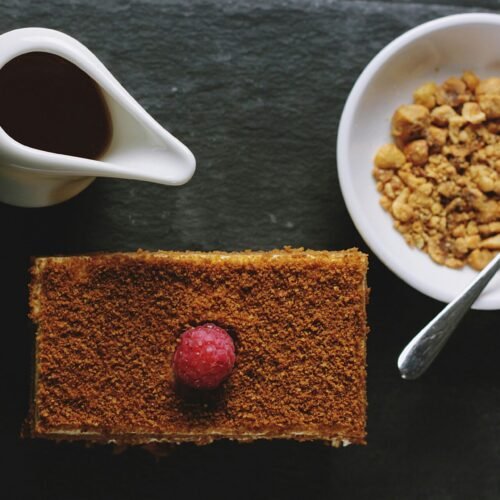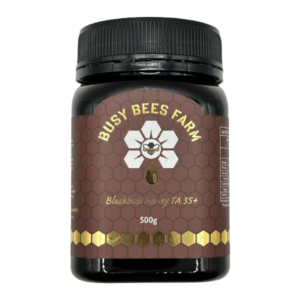
The Russian Honey Cake, or Medovik, is a delectable dessert that holds a special place in the hearts and kitchens of many. This layered cake is known for its intricate combination of honey-infused layers and creamy fillings, making it a beloved treat in Russian cuisine. The origins of Medovik date back to the 19th century, during the reign of Emperor Alexander I. Legend has it that one of his chefs created the honey cake to impress the Empress, who was initially indifferent to honey. The cake’s irresistible taste, however, won her over, cementing its place in Russian culinary tradition.
Medovik’s historical roots are not merely confined to the imperial court but are deeply ingrained in Russian culture. Honey, an essential ingredient in Medovik, was cherished in Russian households for its natural sweetness and health benefits. Over time, the cake evolved from a royal delicacy to a staple in family celebrations, from birthdays to weddings. Its popularity spread beyond Russia’s borders, captivating dessert enthusiasts around the globe with its unique flavor profile and texture.
The cultural significance of Medovik extends beyond its taste. It represents the ingenuity and resourcefulness of Russian bakers who, despite the simplicity of ingredients, create a complex and delightful treat. Each layer of the cake is meticulously prepared, echoing the patience and craftsmanship inherent in traditional Russian baking. For many, making Medovik is a cherished family tradition, passed down through generations, preserving the essence of their heritage.
Today, Russian Honey Cake is celebrated not only in Russia but also in various international culinary circles. Its global appeal is a testament to its timeless charm and the universal love for desserts that tell a story. Whether enjoyed in a cozy Russian home or a chic patisserie in Paris, Medovik continues to enchant and delight, bridging cultures and generations with every bite.
The Russian Honey Cake, also known as Medovik, is a delightful confection renowned for its rich, honey-infused layers. The key ingredient, as the name suggests, is honey, which imparts a unique flavor and moist texture to the cake. To begin, gather the essential ingredients: flour, sugar, eggs, butter, baking soda, and, most importantly, honey. These form the backbone of the cake’s dough, while the creamy filling consists of sour cream, sugar, and sometimes added heavy cream for extra richness.
The preparation of Russian Honey Cake involves several steps, each contributing to its intricate layers and exquisite taste. Start by making the dough: in a heatproof bowl, combine honey, sugar, and butter. Heat this mixture gently until it melts and becomes homogeneous. Remove from heat, then mix in the baking soda. This will create a frothy, light texture as the baking soda reacts with the honey mixture. Allow it to cool slightly before adding beaten eggs and flour to form a pliable dough.
Next, divide the dough into several equal portions, typically ranging from six to ten, depending on the desired number of layers. Roll out each portion into thin circles, approximately the size of a dinner plate. Bake each layer separately on a parchment-lined baking sheet at 350°F (175°C) for about 5-7 minutes or until golden brown. Keep a close eye, as these layers bake quickly. Once baked, allow them to cool completely.
While the layers cool, prepare the creamy filling by whipping together sour cream and sugar until smooth. For an added touch of decadence, incorporate heavy cream to achieve a more luxurious texture. To assemble the cake, generously spread the filling between each baked layer, stacking them carefully. Cover the entire cake with the remaining filling and let it sit in the refrigerator for several hours, or preferably overnight, to allow the flavors to meld and the layers to soften.
For a traditional twist, some variations of Medovik incorporate walnuts or dried fruits between the layers, adding a delightful crunch and burst of flavor. Regional differences may also include the use of different types of honey, such as buckwheat or wildflower, each imparting its own unique taste profile. By following these steps and incorporating these tips, you can create a Russian Honey Cake that is both visually stunning and irresistibly delicious.
Layering is the cornerstone of crafting the classic Russian Honey Cake, also known as Medovik. This multi-layered dessert achieves its characteristic texture through a meticulous process that involves alternating layers of honey-infused sponge and cream filling. Each layer contributes to the cake’s overall depth, making every bite a symphony of flavors and textures.
The process begins by preparing thin layers of honey sponge cake. Traditionally, these layers are rolled out to an even thickness and baked individually. Once cooled, the real artistry of assembly begins. The key to a successful Russian Honey Cake lies in the even distribution of the cream filling. This filling, often made from a blend of sour cream and sweetened condensed milk, is spread generously between each sponge layer. The goal is to ensure that the cream is evenly distributed, covering every inch of the sponge to prevent dryness and enhance the cake’s moist texture.
Achieving a visually appealing finish is equally important. Some bakers use a palette knife or a spatula for smooth, even layers of cream. Modern techniques may involve using a piping bag to control the amount and distribution of the filling more precisely. Each layer should align perfectly to maintain the cake’s structural integrity, and a final coating of cream envelops the entire cake, providing a smooth surface for any decorative elements.
Once assembled, the Russian Honey Cake requires time to set. This resting period, ideally overnight or up to 24 hours, allows the flavors to meld together. The cream permeates the sponge layers, resulting in a harmonious blend of honeyed sweetness and creamy tanginess. The cake’s texture transforms from crisp and crunchy to soft and moist, making it a delight to the palate.
Perfecting the art of layering and assembly in Russian Honey Cake not only showcases the baker’s skill but also pays homage to the traditional techniques that have been passed down through generations. Whether adhering to classic methods or incorporating modern twists, the intricate process of creating this beloved dessert is a testament to its enduring appeal.
Russian Honey Cake, known for its intricate layers and rich flavor, deserves thoughtful presentation to fully appreciate its culinary charm. To maximize its flavor, it is best served at room temperature. This allows the cake’s textures and honey-infused layers to meld harmoniously, enhancing each bite’s complexity. When slicing, use a sharp knife to maintain the cake’s structural integrity and reveal its beautiful layers.
For an added touch of elegance, consider garnishing the cake with fresh berries, mint leaves, or a light dusting of powdered sugar. These simple yet effective embellishments can elevate the cake’s visual appeal and provide a pleasant contrast to its sweetness. Pairing the cake with complementary beverages can further enhance the dining experience. Traditional choices include a robust black tea or a fragrant cup of chamomile tea, both of which balance the cake’s sweetness and cleanse the palate between bites. For a more indulgent pairing, a glass of dessert wine, such as a late harvest Riesling, can accentuate the honey notes beautifully.
Russian Honey Cake is versatile enough to suit various occasions. It shines as the centerpiece of festive celebrations like birthdays, anniversaries, or holiday gatherings, where its rich flavors and impressive presentation leave a lasting impression on guests. However, its comforting and homey qualities also make it a delightful choice for casual family get-togethers or weekend tea parties. Anecdotes from those who have savored this cake often highlight its role in creating memorable moments, whether it’s a grandmother passing down the recipe to her grandchildren or friends bonding over shared slices.
Reflecting on its enduring popularity, Russian Honey Cake remains a timeless favorite due to its unique combination of flavors and textures. Its ability to bring people together, evoke nostalgia, and create new memories ensures that this beloved dessert continues to be celebrated and cherished across generations.











